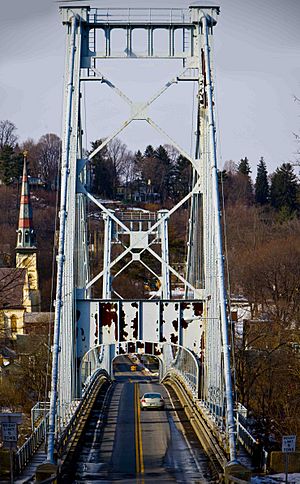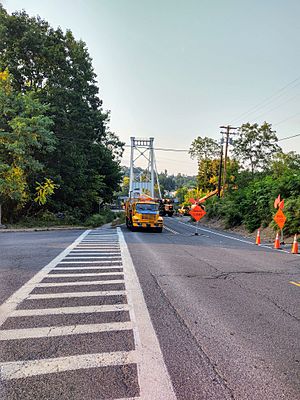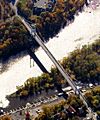Kingston–Port Ewen Suspension Bridge facts for kids
Quick facts for kids Kingston–Port Ewen Suspension Bridge |
|
|---|---|

Bridge looking north into Kingston, 2007.
|
|
| Coordinates | 41°55′02″N 73°59′03″W / 41.91716°N 73.984165°W |
| Carries | Wurts St. (Old |
| Crosses | Rondout Creek |
| Locale | Kingston, New York |
| Official name | Kingston–Port Ewen Suspension Bridge |
| Maintained by | New York State Department of Transportation |
| ID number | 1007350 |
| Characteristics | |
| Design | Wire cable Suspension bridge |
| Total length | 2 side spans of 176.25 feet (54 m) each, anchorages, total length 1,145 ft (349 m) |
| Width | 2 lanes plus walkway, 37 feet (11 m) |
| Longest span | 705 feet (215 m) |
| Clearance below | 85 ft (26 m) |
| History | |
| Opened | 1921 |
| Closed | Permanently on 25 Sept. 2020 |
| Statistics | |
| Daily traffic | 15,700 |
| Toll | no |

TIGER image, Red dot marks bridge
|
|
The Kingston–Port Ewen Suspension Bridge is a cool bridge that crosses Rondout Creek in New York. It's also known as the "Rondout Creek bridge," the "Old Bridge," or the "Wurts Street Bridge." This bridge connects the city of Kingston on the north side with the village of Port Ewen on the south.
Completed in 1921, it was an important part of New York's first main north-south road along the Hudson River. It was a big deal for early cars and how people traveled.
Building the Bridge
Building the Kingston–Port Ewen Suspension Bridge began in 1916. The goal was to replace an old ferry called Skillypot, which didn't always run on time.
The bridge was designed by famous engineering companies, including Holton D. Robinson and John A. Roebling's Sons Company. The main engineers were Holton D. Robinson, Daniel E. Moran, and William Yates.
Building the bridge faced many challenges. There were local political and money problems. Also, World War I caused shortages of materials. Because of these issues, construction stopped until 1920.
When work started again, David B. Steinman, who later became a very famous bridge engineer, was part of the team. The bridge took about a year to finish. There's a local story that a woman worked as a welder on the bridge. This was very unusual in 1920, though it became more common during World War II.
The bridge officially opened on November 2, 1921. Ten thousand people came to celebrate! The north side of the bridge has a very hilly road leading up to it. It also crosses a small island in the creek. The bridge creates a beautiful view for the nearby Rondout–West Strand Historic District.
Bridge's Role and Closure
When the bridge first opened, it was a key part of U.S. Route 9W. This was a major road for cars. However, in 1978, Route 9W was moved to a newer, larger bridge called the John T. Loughran Bridge.
Over the years, the old bridge's weight limits were lowered. This meant fewer and lighter vehicles could use it. Finally, in September 2020, the bridge was closed to all traffic.
The Kingston–Port Ewen Suspension Bridge even appeared in the TV show The Undoing.
Why the Bridge Closed
The Kingston–Port Ewen Suspension Bridge was getting old. It was considered "structurally deficient" by transportation experts. This means it wasn't as strong as it needed to be.
Engineers regularly checked the bridge. In April 2008, they inspected the main cables, which are super important for a suspension bridge. They found the cables were in good condition. There were plans to fix up the bridge, including replacing the road, but these plans didn't happen.
On September 25, 2020, at 5:55 PM, the New York State Department of Transportation (NYSDOT) closed the bridge for good. This was because the metal parts holding up the road (called suspended trusses) were badly rusted. At the time, there were no plans to fix or reopen it. This means the bridge was open for almost 99 years!
Images for kids





